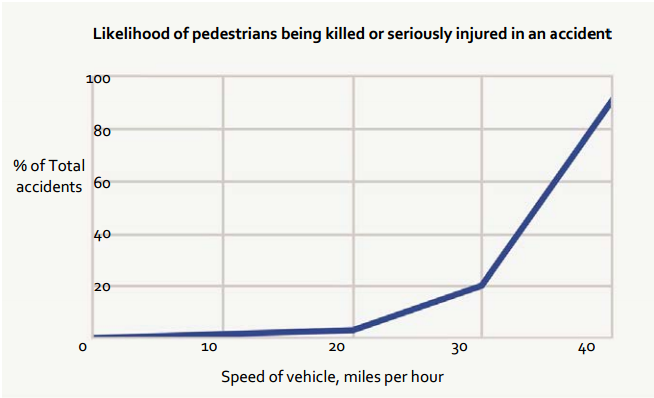A newly published guide to street design sets out the latest thinking on how roads and streets in cities, towns and villages can be decluttered and redesigned to make them not only pleasanter to look at and to use, but also significantly safer.
Street Design for All - "a compilation of current thoughts and practices in the art of Street Design" - reflects the work and ideas of professional road engineers and of campaigners for improvements to the "public realm".1 It provides an easy to understand explanation of how established urban street design practices that were intended to improve safety have in many cases had the opposite effect.
The innovative new approaches to street design that the booklet describes have been proven to reduce casualties without causing additional traffic congestion. In addition, by enhancing the attractiveness of the public realm they encourage people to regard urban streets as places to visit rather than just to pass through, bringing benefits in terms of both economic and psychological wellbeing.
Significantly, the new guide has been endorsed by Robert Goodwill, the Minister for Transport, who has recommended its use by local community groups to help them contribute to the redesign of their localities.
The arguments set out in the booklet include the following points:
- Design and manage the street for a sense of place as well as for movement. It is important to understand how a particular street works as an individual place; particularly the human activities that give a street its character.
- Design the street to enhance its sense of place. People appreciate streetscape, not only fine vistas and historic buildings but the seemingly ordinary. It is important to cut street clutter so that disabled people can move about more easily and the special qualities of a place can be seen more clearly.
- Encourage wellbeing through healthy, active lifestyles. Wellbeing includes mental as well as physical health. Streets that are designed to be interesting, welcoming and safe encourage more people to walk and cycle as part of their daily life.
- Design and manage the highway to make unsafe actions less likely. A greater understanding of drivers’ behaviour based on what they actually comprehend as they travel along a road helps anticipate how they are likely to react to various street conditions. If the road is "self-explanatory", drivers are more likely to know what to expect in the road ahead.
- Aim for total street design-not just individual uncoordinated components. Quality streets balance the needs of all road users: pedestrians, cyclists, people with disabilities and drivers.
A running theme is the importance of "decluttering". Apart from the obvious aesthetic benefits of reducing the amount of intrusive street furniture, road safety is actually increased by dispensing with the proliferation of signs, road markings, traffic lights etc. These are all intended to reduce the likelihood of accidents, but paradoxically, because they increase driver confidence, they lead to increased speeds and decreased driver vigilance, and hence to more collisions with worse consequences. Better to design "self-explaining roads" - roads that on the one hand will reduce driver confidence, making them slow down and become more vigilant, while in the other hand making it easier for them to see potential problems because their attention is not distracted by a large number of signs and markings.

The booklet contains sections on streetscape and creating a sense of place and goes into some detail with regard to the design of pedestrian crossings, the best types of paving slabs and "street corner geometry" (an important aspect of pedestrian safety).
It concludes with some advice about undertaking local projects and assessing whether the correct balance has been struck between road safety and other considerations.
1 Street Design for All by Colin J Davis, published by CJDA Ltd for PRIAN 2014. Available for free download from this link. The publication was issued jointly by the Public Realm Information & Advice Network (PRIAN), the Chartered Institution of Highways and Transportation (CIHT), Civic Voice and the Department for Transport, with assistance from English Heritage, the Institute of Highway Engineers, Living Streets, the National Heart Forum, Transport for London and the Urban Design Group.